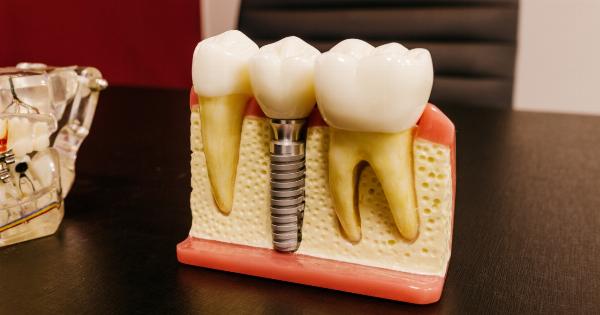When it comes to innovative solutions, Germany has always been at the forefront. And this time, they have once again proven their brilliance by coming up with a golden solution to a tiger’s broken tooth.
This breakthrough in dental care for animals has not only saved numerous tigers from excruciating pain but has also revolutionized the field of veterinary dentistry.
The Problem: Tigers with Broken Teeth
Tigers, being powerful predators, rely heavily on their teeth for hunting, eating, and even defending themselves. However, just like humans, they are also susceptible to dental issues.
One of the most common problems observed in tigers is broken teeth, which can cause immense pain and hinder their ability to survive in the wild.
The Traditional Approach: Metal Crowns
In the past, when a tiger broke its tooth, the traditional approach involved the use of metal crowns to restore the tooth’s functionality. While this method did alleviate the pain to a certain extent, it had its limitations.
Metal crowns were prone to develop complications over time, causing discomfort and requiring frequent replacements.
Moreover, these metal crowns posed a significant risk for tigers in the wild. Their shiny metallic appearance made it easier for other animals to spot and potentially attack them.
This was a matter of concern for conservationists who wanted to ensure the safety and well-being of these majestic creatures in their natural habitats.
The Golden Solution: Gold Crowns
Recognizing the limitations of metal crowns, German scientists, in collaboration with experienced veterinary dentists, decided to explore alternative materials for dental restoration in tigers.
After extensive research and testing, they found that gold crowns offer the optimal solution.
Gold crowns not only provide excellent durability but also offer a more aesthetically pleasing solution. The natural color of gold blends seamlessly with the tiger’s teeth, making it virtually indistinguishable from the original tooth.
This eliminates the risk of making the tiger a target for predators or causing unnecessary stress due to its altered appearance.
The Benefits of Gold Crowns for Tigers
The implementation of gold crowns in tiger dentistry has brought forth a myriad of benefits:.
1. Improved Functionality
Gold crowns restore the broken tooth’s functionality, allowing tigers to hunt, chew, and defend themselves without hindrance. This ensures their survival and overall well-being as apex predators in their respective habitats.
2. Minimized Risk of Complications
Compared to metal crowns, gold crowns have shown a significantly lower risk of developing complications over time. This means fewer dental procedures and reduced discomfort for the tigers.
3. Enhanced Protection in the Wild
The natural color of gold blends seamlessly with the tiger’s teeth, providing them with enhanced protection in the wild. Their teeth no longer stand out, reducing the chances of attracting unnecessary attention from potential threats.
4. Long-lasting Solution
Gold crowns have demonstrated exceptional durability, ensuring a long-lasting solution for tigers with broken teeth. This reduces the need for frequent replacements, minimizing stress and discomfort for the animals.
The Impact on Veterinary Dentistry
Germany’s brilliant solution in using gold crowns for tiger dental care has not only revolutionized the treatment of these majestic creatures but also left a significant impact on the field of veterinary dentistry.
This breakthrough has opened new doors for exploring alternative materials and techniques for dental restoration in other animals as well.
The successful application of gold crowns in tigers has sparked interest among veterinary dentists worldwide.
Experts are now looking into implementing similar approaches in various other species, ranging from lions and leopards to domestic pets like cats and dogs.
Furthermore, this golden solution has shed light on the importance of dental health in animals.
Veterinarians are now more vigilant in preventive care and regular check-ups to identify dental issues early on and provide timely treatment to ensure the overall well-being of their animal patients.
The Conservation Implications
Tigers are an endangered species, and every effort to protect and conserve them plays a crucial role in their survival. Germany’s golden solution not only improves the lives of tigers but also aids in their preservation.
By minimizing the risk of complications and improving the tigers’ functionality, the application of gold crowns allows these majestic creatures to thrive in their natural habitats.
It enables them to hunt efficiently, consume a varied diet, and maintain their position as apex predators.
Moreover, the reduced risk of attracting attention from predators due to the natural appearance of gold crowns helps ensure the safety of tigers, especially in the wild.
This contributes to their well-being and increases the chances of successful breeding and population growth.
The Future of Dental Care for Animals
Germany’s brilliance in finding a golden solution for a tiger’s broken tooth has paved the way for future advancements in dental care for animals.
It has highlighted the importance of innovative thinking and the exploration of alternative materials for effective dental restoration.
As veterinary dentists around the world analyze the success of gold crowns in tiger dental care, it is anticipated that similar solutions will emerge for other animal species as well.
This will not only improve the quality of life for these animals but also contribute to their overall conservation and well-being.
With ongoing research and collaboration among experts in veterinary dentistry, the future holds promising developments in the field.
The golden solution introduced by Germany is just the beginning, and we can expect even more ingenious solutions to improve the dental health of animals in the years to come.
Germany’s golden solution in using gold crowns for tigers’ broken teeth has revolutionized veterinary dentistry, providing a durable and aesthetic solution while ensuring their survival and conservation..






























